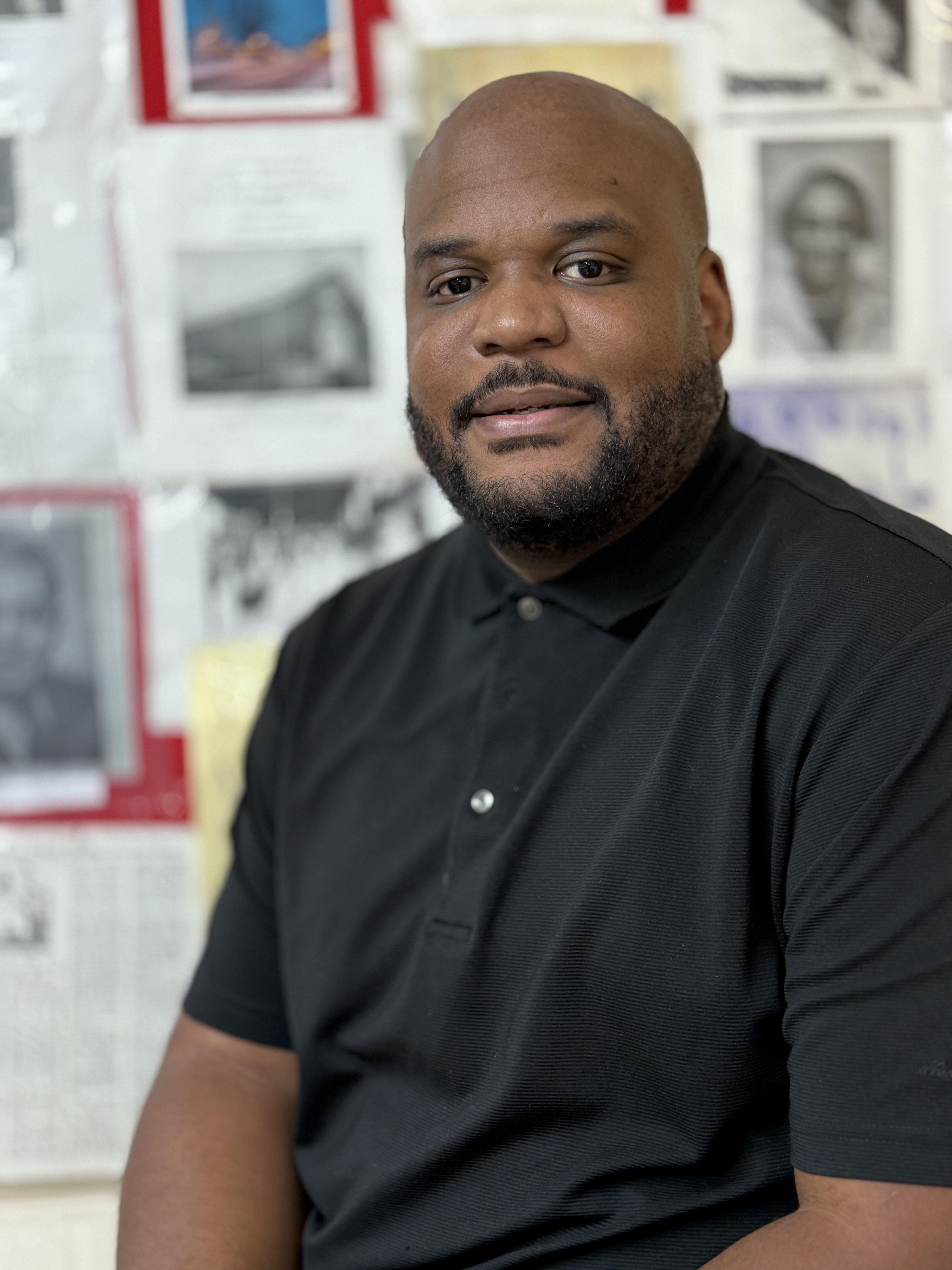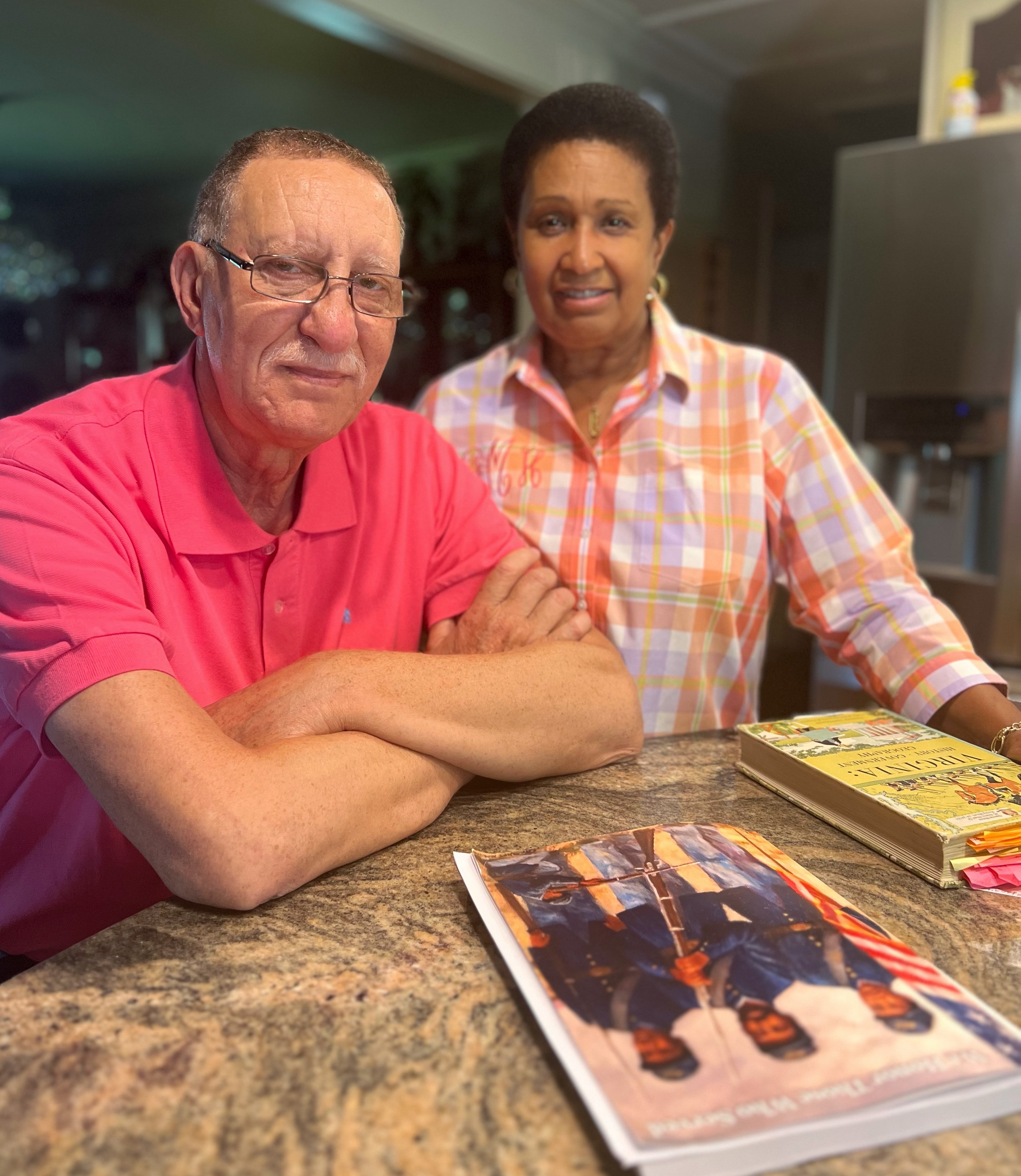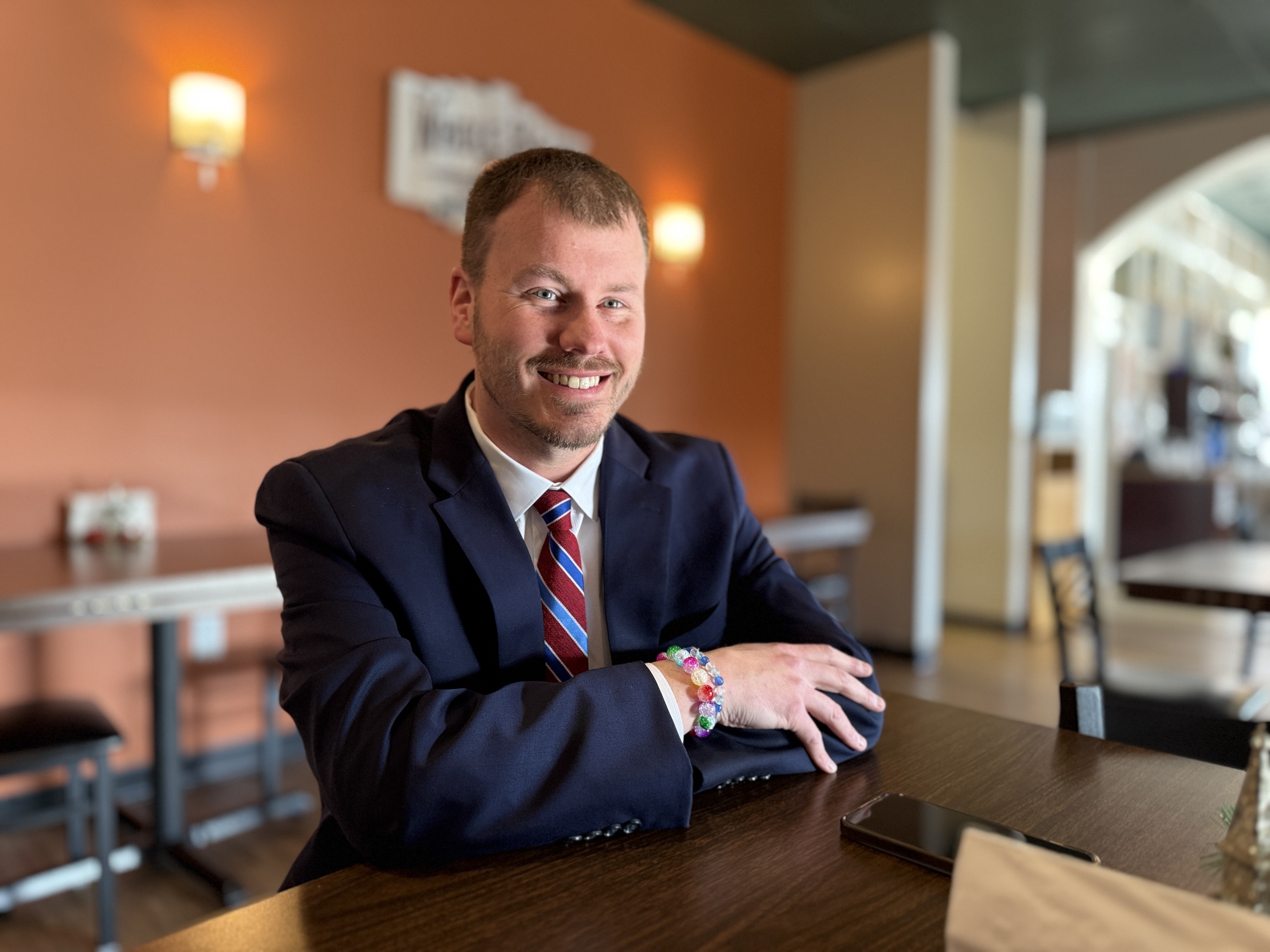Cardinal News: Then & Now takes a look back at the stories we brought you over the last 12 months. Through the end of the year, we’re sharing updates on some of the people and issues that made news in 2024. This installment: the monument to Black Union soldiers planned for Rocky Mount.
This holiday season, Rocky Mount’s Raising the Shade monument committee and the Franklin County NAACP have an extra-special reason to celebrate: First Baptist Church has opened its arms to the project.
A year from now, a monument to the county’s 70 Black soldiers who fought for the U.S. in the Civil War will be unveiled at the church’s historic location in downtown Rocky Mount.
Earlier this year, Virginia Tech’s Monuments Across Appalachian Virginia project awarded $285,000 in Mellon Foundation funds to the committee.
The idea for the monument arose in 2020 when Glenna Moore started researching Franklin County’s Black veterans. She found three who had been born in Franklin County and who had fought for the U.S. Colored Troops. As her research deepened, Moore’s list expanded to include 70 such Black men.
Since then, the proposed location of that monument has been the subject of some discord in the town. While the Raising the Shade steering committee initially agreed that the Veterans Memorial Park was a satisfactory option as a location for the monument, that committee left the door open for at least one other site to be considered: the Rocky Mount farmers market. But early in the process, town officials determined that if the monument was to be installed, it would be placed in the Veterans Memorial Park.
When the Raising the Shade committee and the Franklin County NAACP, which is managing its funds, could not reach an agreement with the town, the church stepped in.
When it is completed in 2025, the monument will stand on the grounds of the historically Black former First Baptist Church, a building in a highly visible location near the entrance to downtown Rocky Mount. The church had earmarked that building to be used as a community center, said the Rev. Christopher Coates.
The story of the U.S. Colored Troops fighting for their own freedom goes hand in hand with the fortitude of First Baptist Church’s founding members, who raised a church in the midst of the Jim Crow South, Coates said. “It had to have been a radical thing.”
“It’s almost like this is where the monument was meant to be in the first place,” said Eric Anspaugh, chair of the Franklin County NAACP.
The 3 men who started it all
As the calendar folds into a new year, Anspaugh and the rest of the Raising the Shade committee can focus on what the future will hold — not just the 7-foot bronze statue of a soldier, but also who that statue will represent.
“We can continue to focus on the larger part of the story,” Anspaugh said.
These soldiers were men who fought for their own freedom and equality, as well as for the preservation of the United States during the Civil War, according to the monument committee. That committee is dedicated to sharing their stories, and to educating people about the significance of their role in American history.
Black men have fought for America since the Revolution but, following the Federal Militia Act of 1792, they were prohibited from enlisting. When the War of 1812 broke out, some free recruits enlisted to fight for the U.S., most notably in the Navy, filling gaps in manpower and ultimately comprising 15% to 20% of the Navy’s response in that war.
Black people would not join the U.S. military in any large number until a few months into the Civil War.
Six weeks into the Civil War, Frank Baker, James Townsend and Shepard Mallory of Hampton, all men who were Black and enslaved by Confederate Col. Charles Mallory, were ordered to build an artillery emplacement on Sewell’s Point, across the mouth of the James River from U.S. Fort Monroe.
The men learned that Mallory intended to take them to North Carolina to continue serving the Confederacy away from their families in Hampton. They instead fled by boat to Fort Monroe, seeking a chance at freedom.
Legally, the Fugitive Slave Act stated that the three men would have to be returned to Mallory. Instead, Maj. Gen. Benjamin Butler took a different approach. He reasoned that the Confederacy considered Baker, Townsend and Mallory to be Mallory’s property and that the men were being used against him just across the river.
Butler decided that, for the purpose of granting them refuge, the men would be considered contraband of war — property transferred from the Confederacy to the U.S. in times of war for use against the nation’s adversaries. His logic partially hinged on Virginia having seceded from the U.S., removing any constitutional obligation he had to return the three men to a foreign state.
President Abraham Lincoln allowed Butler’s decision to stand, and Baker, Townsend and Mallory became the first three men granted refuge at Fort Monroe, which became known as Freedom’s Fortress as enslaved men began to flock to the fort.
When these refugees arrived with few provisions, they were left to work for the federal government or Union Army in exchange for rations and shelter in government-sanctioned Contraband Encampments, the White House Historical Society reports. Those living conditions may have led some to enlist in the U.S. Army.
Nearly 200,000 Black soldiers signed up to fight for the U.S. during the Civil War, leading to the formation of the U.S. Colored Troops in 1863.
The Black men who joined the ranks of the Army and Navy would have served in a wide variety of roles — as carpenters, cooks, laborers, pilots, surgeons and more. Black infantrymen were rare.
A class at Virginia Tech, led by Sarah Plummer, spent the fall semester digging into the research, trying to understand what life may have been like for these soldiers. The amount of information available could fill a steamboat. What’s missing could fill a port.
Some information can be found in veterans’ narratives contained in pension files, if the veteran ultimately filed for a pension — and if the name under which the veteran filed for his pension is known. In the case of veterans who were formerly enslaved, they may have changed their names between the time they served and the time they filed for their pensions, according to an article by Donald Shaffer and Elizabeth Regosin for Prologue, a magazine of the National Archives.
Some information can be found at historical societies or in church basements, or in other places where documentarians have thought to record it.
‘Their spirit made the church’
Coates is the 16th pastor of his church, a historically Black congregation that now meets on Patterson Avenue in Rocky Mount. He is proud of his church history.

A church is not a building; it is the people, Coates says.
The people who founded First Baptist Church first began meeting in the late 1800s, perhaps only 20 or so years after those 70 Black soldiers had signed up to fight for their own freedom and to protect the fabric of the U.S, in war.
“They met in an old schoolhouse, wherever, in places where people can gather, and their spirit made the church,” he said.
Some of those first church members, the ones who raised the money to build the structure on Franklin Street, are said to have been people who were formerly enslaved, as well as children of the formerly enslaved community.
According to a deed provided by the historical society, in 1899, J.W. Cassell and C.C. Cassell sold a plot of land near the town’s railroad station. Five First Baptist Church trustees signed the deed. Foster Saunders, a Black man, was one of them.
An essay by the late Joe Ben Jamison reported that the First Baptist congregation may have raised as little as $2 a week at times, but eventually, members gathered $500 and hired architect Leonard Pinkard to design a church building. By 1907, that building had opened for worship.
First Baptist will soon begin renovations to turn the building into a multipurpose community center that will be available for meetings, activities and educational opportunities.
The church has secured a loan to cover costs for the majority of the needed construction, and hopes to fill the gaps with grants.
The renovation will preserve the historical aspects of the building while upfitting it for modern uses, Coates said.
Since the church moved its worship center to Patterson Avenue in 1965, the Franklin Street location has been used as a community center and a hair salon. Most recently, the building has sat vacant.
The small white church is raised on a knoll, standing just above Franklin Street. If you stand in the churchyard, it feels like you can look all the way down Main Street, and up the other way too.
This plot of land feels small-town perfect. With garland wrapped around the light posts and a bite in the air, it feels like a Hallmark movie. It’s just missing its people.
A question of visibility
Throughout the spring, the Raising the Shade steering committee attempted to work with the mayor and town manager to discuss potential alternatives for the monument’s location.
The committee had reservations about Veterans Memorial Park. The park’s location on the edge of town was a primary concern, but the site along the Pigg River is also one with a history of flooding. There were additional concerns about the new statue not fitting in with the aesthetic of the park.
The committee had only considered the park as a placeholder location for the purpose of the grant application, members maintained, having verbally discussed their short list of locations with town officials prior to submitting the grant application.
Town officials held steady: The proposed monument would be located in that park.
By the time of the June 10 town council meeting, the monument committee had not yet made a formal written request to locate the monument at the farmers market instead of Veterans Memorial Park. At that night’s meeting, the town council made an official recommendation for the veterans commission to consider placing the monument at the park.
Ten days later, the commission met and the location was approved.
Within a week, the monument committee revisited the park and the market to again discuss the benefits of each location, Moore said. Dialogue continued over the next month.
The primary sticking point: visibility.

Moore first publicly recognized the 70 soldiers who will be represented by that statue in 2020. That year, she read their names aloud at Franklin County Board of Supervisors public meetings.
During that same period, the county was debating whether or not the Confederate monument on the Franklin County Courthouse lawn should be removed. It had been erected in 2010, after the original was irreversibly damaged in a 2007 vehicle vehicular crash. That debate went to a public referendum and the statue still stands.
According to Moore’s count, there are five references to the Confederacy that visitors would encounter within a half- mile of that courthouse. She listed them at a Rocky Mount Town Council meeting on Sept. 9.
“As a retired educator, I expected the town council to appreciate and showcase the unique history of these remarkable African American soldiers at the clock and the farmers market area,” she said at that meeting.
Moore referenced the town’s 2015-2045 comprehensive plan, stating that she believed the statue would have supported the plan’s goals of adding vitality to downtown through arts and culture.
“Raising the Shade told us the entire time they wanted a more visible location, and that they did not think the veterans park was as visible or as high foot traffic area as they wanted,” Perdue said. “Did it surprise me that they continued to talk about the farmers market? No, it didn’t surprise me.”
‘A weight has been lifted’
On July 25, sculptors Paul DiPasquale and Rick Weaver arrived for a community listening session at The Harvester, an integral component of every project that receives a MAAV grant.
They toured the town, accompanied by Wood, Anspaugh and members of the monument committee. They visited the proposed sites, both the approved Veterans Memorial Park and the farmers market.
During the tour, the artists expressed more enthusiasm for the farmers market site than the park, Anspaugh said.
Though the two areas are only a mile apart, their settings differ.
The park stands near the edge of town; its closest neighbors are a motorcycle supply shop, a center for aging and a textile wholesaler. A patio is paved with bricks honoring those who served. Flags fly overhead. On a summer day, a couple might stop in the parking lot to eat their lunch. Other than that, there aren’t many visitors.
The farmers market is tucked in the bustling middle of Rocky Mount’s downtown district. Weekends are full of shoppers picking up fresh vegetables or a homemade pie. Families walk by on their way to the library or for a meal at one of several restaurants. The Harvester is just across the street.
“They said, ‘This is where it needs to be,’” Anspaugh recounted, regarding the sculptors’ reaction to the area.
Two hundred people came to the listening session at The Harvester, Anspaugh said. After the meeting, the community’s energy was high.
At Perdue and Wood’s request, Anspaugh called the monument committee to gather.
Perdue and Wood reiterated the town’s stance regarding the monument’s approved location. They were also concerned about the appearance of ongoing controversy in the town, Perdue said. They worried that the community would not find a way to work together if they became too divided over the matter of the monument’s location, Wood later explained.
Eventually, Coates began to hear chatter in the community and among his church members. He had already begun to consider that the statue might be a good fit for the church’s Franklin Street property, but he had yet to approach the rest of the committee or the NAACP — or even his church membership — with the idea.
And then his phone rang. Rocky Mount town Councilman Ralph Casey was on the other end.
Casey also thought that the former church building would make a nice site for the monument, and for a museum or community center, too.
Casey had confirmed with Rocky Mount Ready Mix that the church location would be suitable for a monument foundation prior to picking up the phone.
Coates confirmed he was willing to offer the church as a monument for the location.
“And so I said, ‘That’s a win-win,’” Casey said.
When Coates presented the idea to the congregation, “nobody objected at all.”
“I went to a couple of meetings. I said, ‘This is my suggestion, and I’m done with it.’ And I walked away. The next thing I knew, they decided the monument would be at First Baptist Church,” Casey said.
On Sept. 8, First Baptist sent the Raising the Shade committee a letter of understanding, supporting the installation of a statue honoring those 70 Black U.S. soldiers to be placed at their old church property.

The NAACP and the Raising the Shade committee readily accepted that agreement.
“It’s in the downtown area. Everybody is happy,” Perdue said.
The church intends to celebrate the community center’s opening at the same time the Raising the Shade monument is unveiled. The end goal for both projects is December 2025.
“Everyone at the town agrees that it is a big accomplishment to go from the point of first learning about these people from Franklin County who fought as part of the U.S. Colored Troops to actually realizing the dream of having the monument in place to commemorate them. It’s a really big deal for the community,” Wood said.
“It feels like a weight has been lifted off our shoulders,” Anspaugh said. “We’re celebrating.”



